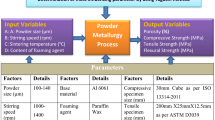Abstract
In the present study, aluminum alloy 7075 (Al7075)-based open-cell silicon carbide (SiC) foam composite was fabricated and the machinability of both Al7075 and the open-cell SiC foam Al metal matrix composite was investigated during milling using an uncoated carbide tool. The machining trials were conducted using the Taguchi L27 full-factorial orthogonal array, and the milling parameters were optimized for surface roughness. Analysis of variance was employed to determine the effect of the cutting variables on surface roughness. The experimental results were evaluated by signal-to-noise ratio, 3D surface graphs, artificial neural networks (ANNs) and main effect graphs. The analysis results show that the feed rate was the most significant milling parameter affecting surface roughness of both Al7075 and the open-cell SiC foam composite. Prediction models have been developed for the surface roughness through regression analysis and ANNs. Confirmation experiments were performed to identify the performance of mathematical models, and the surface roughness was predicted with a mean squared error equal to 1.6 and 0.24 % in the milling of Al7075 and open-cell SiC foam composite, respectively. The test result showed that the three-dimensional open-pore SiC foam network reinforcement was restricted the movement of the soft matrix and provided an acceptable surface quality in the milling of MMCs.












Similar content being viewed by others

References
Bhushan RK, Kumar S, Das S (2010) Effect of machining parameters on surface roughness and tool wear for 7075 Al alloy SiC composite. Int J Adv Manufact Technol 50:459–469
Zhu X, Jiang D, Tan S (2015) Reaction bonding of open cell SiC–Al2O3 composites. Mater Res Bull 36:2003–2015
Mollicone J, Ansart F, Lenormand P, Duployer B, Tenailleau C, Vicente J (2014) Characterization and functionalization by sol-gel route of SiC foams. J Eur Ceram Soc 34:3479–3487
Liu Y, Edouard D, Nguyen LD, Begin D, Nguyen P, Pham C, Pham-Huu C (2013) High performance structured platelet milli-reactor filled with supported cobalt open cell SiC foam catalyst for the Fischer–Tropsch synthesis. Chem Eng J 222:265–273
Montanaro L, Jorand OY, Fantozzib G, Negroa A (1998) Ceramic foams by powder processing. J Eur Ceram Soc 18:1339–1350
Zhao LZ, Zhao MJ, Yan H, Cao XC, Zhang JS (2009) Mechanical behavior of SiC foam-SiC particles/Al hybrid composites. Trans Nonferrous Metals Soc China 19:547–551
Muthukrishnan N, Davim JP (2009) Optimization of machining parameters of Al/SiC-MMC with ANOVA and ANN analysis. J Mater Process Technol 209:225–232
Sahoo AK, Pradhan S (2013) Modeling and optimization of Al/SiCp MMC machining using Taguchi approach. Measurement 46:3064–3307
Muñoz-Escalona P, Maropoulos PG (2010) Artificial neural networks for surface roughness prediction when face milling Al 7075-T7351. J Mater Eng Perform 19:185–193
Oktem H, Erzurumlu T, Çöl M (2005) A study of the Taguchi optimization method for surface roughness in finish milling of mold surfaces. Int J Adv Manuf Technol 28:694–700
Kiliçkap E, Çakir O, Aksoy M, Inan A (2005) Study of tool wear and surface roughness in machining of homogenised SiC-p reinforced aluminum metal matrix composite. J Mater Process Technol 164–165:862–867
Manna A, Bhattacharyya B (2004) Investigation for optimal parametric combination for achieving better surface finish during turning of Al/SiC-MMC. Int J Adv Manuf Technol 23:658–665
Davim JP, Antonio CAC (2001) Optimization of cutting conditions in machining of aluminium matrix composites using a numerical and experimental model. J Mater Process Technol 112:78–82
Vakondios D, Kyratsis P, Yaldiz S, Antoniadis A (2012) Influence of milling strategy on the surface roughness in ball end milling of the aluminium alloy Al7075-T6. Measurement 45:1480–1488
Karthikeyan R, Ganesan G, Nagarazan RS (2001) A critical study on machining of Al/SiC composites. Mater Manuf Process 16:47–60
Rao B, Shin YC (2001) Analysis on high-speed face-milling of 7075-T6 aluminum using carbide and diamond cutters. Int J Mach Tools Manuf 41:1763–1781
Benardos PG, Vosniakos GC (2002) Prediction of surface roughness in CNC face milling using neural networks and Taguchi’s design of experiments. Robot Comput Integr Manuf 18:343–354
Vrabel M, Mankova I, Beno J, Tuharsky J (2012) Surface roughness prediction using artificial neural networks when drilling Udimet 720. Procedia Eng 48:693–700
Zain AM, Haron H, Sharif S (2010) Prediction of surface roughness in the end milling machining using Artificial Neural Network. Expert Syst Appl 37:1755–1768
Marimuthu P, Chandrasekaran K (2011) Experimental study on stainless steel for optimal setting of machining parameters using Taguchi and neural network. ARPN J Eng Appl Sci 6:119–127
Zhang JZ, Chen CJ (2009) Surface roughness optimization in a drilling operation using the Taguchi design method. Mater Manuf Process 24:459–467
Krajewski S, Jerzy N, Nowacki J (2015) Structure of AlSi–SiC composite foams surface formed by mechanical and thermal cutting. Appl Surf Sci 327:523–531
Gaitonde VN, Karnik SR, Paulo Davim (2012) Computational methods and optimization in machining of metal matrix composites. In: Machining of metal matrix composites, Springer London, pp 143–162
Mandal N, Doloi B, Mondal B, Das R (2011) Optimization of flank wear using Zirconia Toughened Alumina (ZTA) cutting tool: Taguchi method and regression analysis. Measurement 44:2149–2155
Sözen A, Arcaklioǧlu E (2005) Solar potential in Turkey. Appl Energy 80:35–45
Acknowledgments
The author wish to thank the Hacettepe University Scientific Research Projects Coordination Unit for the financial support provided to this work through the Scientific Research Projects Grant funding number 1743.
Author information
Authors and Affiliations
Corresponding author
Ethics declarations
Conflict of interest
There is no potential conflict of interest.
Human and animal rights statement
Human participants and/or animals were not used in the research.
Informed consent
Informed consent is shown in acknowledgement section.
Rights and permissions
About this article
Cite this article
Karabulut, Ş., Karakoç, H. Investigation of surface roughness in the milling of Al7075 and open-cell SiC foam composite and optimization of machining parameters. Neural Comput & Applic 28, 313–327 (2017). https://doi.org/10.1007/s00521-015-2058-x
Received:
Accepted:
Published:
Issue Date:
DOI: https://doi.org/10.1007/s00521-015-2058-x



